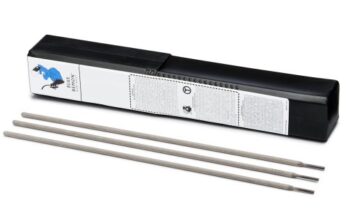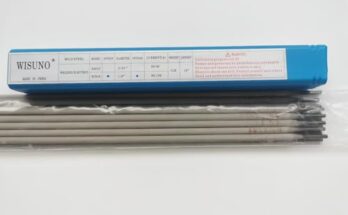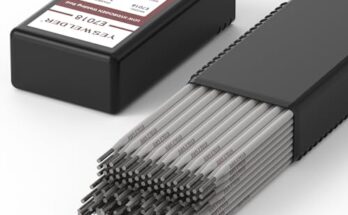Need to repair your exhaust pipe? Choosing the right welding rod is crucial for a strong, lasting repair. This guide will help you find the best welding rod for exhaust pipe, covering everything from rod types to welding techniques. We’ll explore different materials, application methods, and common questions, ensuring you’re ready for the job.
Understanding
Exhaust Pipe Materials and Welding Needs
Exhaust pipes face extreme conditions: high temperatures, vibrations, and exposure to corrosive elements. Therefore, choosing the right welding rod is paramount for a successful and durable repair. The wrong rod can lead to weak welds that crack or fail under stress, potentially causing dangerous exhaust leaks.
Choosing the Right Filler Metal
Exhaust systems are typically made of various materials including mild steel, stainless steel, and sometimes aluminum. Mild steel exhausts are common on older vehicles and often benefit from using a mild steel welding rod, often an E6013 or E7018. These rods offer excellent penetration and are relatively easy to use, making them ideal for beginners and experienced welders alike. E6013 rods are known for their versatility and forgiving nature, while E7018 rods offer superior strength and are preferred for critical applications. The selection largely depends on the thickness of the metal you are working with, the access you have to the area, and your level of experience.
Stainless steel exhausts, more common on newer vehicles, require a stainless steel welding rod. The specific type (e.g., 304L, 308L, 316L) will depend on the composition of the exhaust system. Using an incorrect rod on stainless steel can lead to weld cracking or discoloration due to different expansion rates and corrosion resistance properties. These rods typically require a higher level of skill and control, and maintaining cleanliness during the welding process is absolutely critical to avoid weld porosity or contamination. Using a good quality stainless steel rod is a significant factor in ensuring a long-lasting and corrosion resistant repair.
Considering Weld Joint Design
A successful repair isn’t just about the welding rod; it’s also about the weld joint design. Preparing the exhaust pipe properly is just as important. This includes cleaning the area to be welded thoroughly, removing any rust or scale, and creating a clean, square butt joint or a strong lap joint, whichever is most appropriate for the specific location of repair on the exhaust system. Proper joint preparation minimizes the potential for weld defects and ensures a stronger repair.
Types of Welding Rods for Exhaust Pipes
Several welding rod types are suitable for exhaust pipe repair, each with its strengths and weaknesses. Understanding these differences will help you select the best option for your specific needs and skill level. We need to consider the material of the exhaust pipe (mild steel, stainless steel, aluminum etc.), the thickness of the metal and even the level of expertise the welder possesses.
Mild Steel Welding Rods
Mild steel rods, such as E6013 and E7018, are popular choices for repairing mild steel exhaust systems. E6013 rods are known for their ease of use and good penetration, ideal for beginners. E7018 rods provide higher strength and are often preferred for applications requiring a stronger weld. These rods are generally more affordable compared to stainless steel rods, contributing to their wide usage in automotive repair shops and even at home. They’re available in a range of diameters, allowing you to choose the appropriate size for the thickness of the metal being welded. However, it’s crucial to remember that these rods are not suitable for stainless steel or aluminum exhausts.
Stainless Steel Welding Rods
Stainless steel welding rods are crucial for repairs on stainless steel exhausts. The choice of specific rod type (e.g., 304L, 308L, 316L) depends on the precise composition of the stainless steel in the exhaust system. These rods are designed to provide corrosion resistance and match the thermal expansion properties of the parent metal, preventing weld cracking. These rods require a cleaner welding environment and higher skill levels than mild steel rods. Improper technique with these rods could lead to weld porosity and compromise the weld quality and the corrosion resistance of the repair. The higher cost reflects their specialized properties and need for precise application.
Factors to Consider When Choosing a Welding Rod
Selecting the right welding rod for your exhaust pipe repair requires careful consideration of several key factors. Neglecting these could lead to subpar repairs or even dangerous situations. It’s always better to choose a slightly higher grade rod than necessary to ensure the weld’s strength and longevity.
Rod Diameter and Length
The diameter of the welding rod is directly related to the thickness of the metal you’re welding. Thicker metal requires a larger diameter rod to achieve adequate penetration. Longer rods provide more welding time without needing to change rods frequently, improving consistency. A welding rod that is too thin for a given thickness of metal will likely result in an incomplete weld, while a rod that is too thick may result in excessive heat input and even distortion. Many types are commonly available in 14″ or 18″ lengths.
Flux-Cored vs. Solid Core Welding Rods
Flux-cored rods contain a flux material within the core that protects the weld from oxidation and contamination. This makes them easier to use, particularly in outdoor or windy conditions, and provides more consistent results. Solid core rods require more careful technique, particularly regarding shielding gas usage, to achieve high-quality welds. For exhaust pipe repairs, flux-cored rods are often preferred for their ease of use and the reduced need for specialized equipment, such as a shielding gas supply.
Welding Techniques for Exhaust Pipe Repair
The welding technique significantly impacts the quality and durability of the repair. Proper preparation, consistent welding, and post-weld inspection are essential for a successful outcome. Even a seasoned welder should take the time to perform a thorough weld inspection before proceeding.
Proper Weld Preparation
Before welding, thoroughly clean the area to be welded. This involves removing rust, scale, grease, and paint. Creating a properly fitted joint, whether a butt joint or a lap joint, is essential for a strong weld. Good joint preparation minimizes the chance of weld defects. Consider using a wire brush to properly clean any areas to be welded, especially if there is any evidence of rust or other contamination.
Welding Techniques for Different Materials
Welding techniques vary depending on the material of the exhaust pipe. Mild steel welds often benefit from a consistent, controlled weaving motion, while stainless steel welding frequently requires a more precise and controlled technique, often a single pass to prevent excessive heat input and potential discoloration. Aluminum welding requires specialized rods and techniques that are beyond the scope of this general guide. If you lack the experience in welding aluminum, it is best to seek professional assistance. Improper welding techniques on these materials can result in weakened welds, cracking, or corrosion.
Safety Precautions When Welding Exhaust Pipes
Exhaust pipe welding involves potential hazards, necessitating careful safety measures. Neglecting these precautions can lead to serious injury. Always prioritize safety and take the necessary steps to protect yourself from risks.
Personal Protective Equipment (PPE)
Always wear appropriate personal protective equipment (PPE), including welding gloves, a welding helmet with a suitable shade lens, welding jacket and long sleeves to cover exposed skin, and safety glasses. The intensity of ultraviolet (UV) radiation generated during welding is significant; protection against UV rays should always be a top priority.
Ventilation and Fire Safety
Welding generates fumes, and exhaust pipe repair often involves working near flammable materials. Ensure adequate ventilation to remove fumes, especially in enclosed spaces. Keep a fire extinguisher nearby and be aware of potential fire hazards. Working in a well-ventilated area is extremely important when welding, as it significantly reduces the risk of inhalation of potentially harmful substances.
Common Mistakes to Avoid When Welding Exhaust Pipes
Several common mistakes can compromise the quality and longevity of exhaust pipe welds. Learning from these errors will help you achieve a successful and durable repair. Remember, prevention is key, and careful preparation goes a long way.
Improper Weld Preparation
Failure to properly clean the surfaces before welding is a common mistake. Rust, grease, and paint can prevent proper fusion, leading to a weak weld. This is a significant cause of premature weld failure. Similarly, improper joint fitting can result in stress concentration points and weld cracking under stress.
Incorrect Welding Rod Selection
Using the wrong welding rod for the material can cause several issues. For instance, using a mild steel rod on a stainless steel exhaust can lead to corrosion, discoloration, and weld failure. Ensure you choose the correct rod type for the specific exhaust material.
Choosing the Best Welding Rod Based on Your Skill Level
The ideal welding rod choice also depends on your skill level. Beginners should start with more forgiving options, while experienced welders can explore more specialized rods and techniques. This section focuses on providing guidelines based on experience.
For Beginners
Beginners should opt for E6013 mild steel welding rods. These rods are known for their forgiving nature and ease of use. They provide a good balance of penetration and ease of operation, making them suitable for learning the basics of welding. Focus on developing proper technique before moving to more complex rods.
For Experienced Welders
Experienced welders can explore a wider range of options, including E7018 mild steel rods for higher strength applications, and various types of stainless steel rods based on the exhaust’s material composition. Experienced welders can better handle the nuances of using these rods effectively.
Factors Affecting Weld Quality
Several factors beyond welding rod selection can influence the weld’s quality. Understanding and controlling these elements is crucial for a successful repair. These often-overlooked factors can be crucial to obtaining a successful weld.
Amperage and Arc Length
The amperage setting on the welding machine is critical. Too low amperage can result in insufficient penetration, while too high amperage can cause excessive heat input, leading to burn-through and weld defects. Similarly, maintaining the correct arc length is crucial for consistent heat input and penetration. Using the correct amperage is directly related to the thickness of the material being welded, as well as the type of welding rod.
Welding Machine and Technique
The quality of your welding machine and your welding technique play significant roles in the outcome. A well-maintained welding machine is essential for consistent results. Proper technique, including consistent travel speed and arc length control, is crucial to ensure a high-quality weld. The welding technique is different depending on the type of rod and the material being welded. In the case of stainless steel, for instance, often a single-pass weld is preferred.
Frequently Asked Questions
What is the best welding rod for exhaust pipe made of mild steel?
For mild steel exhaust pipes, E6013 and E7018 rods are excellent choices. E6013 is easier to use for beginners, while E7018 offers superior strength for more demanding applications. Learn more about choosing the right electrode for different steel types.
What type of welding rod should I use for a stainless steel exhaust pipe?
Stainless steel exhausts require stainless steel welding rods. The specific type (e.g., 304L, 308L, 316L) will depend on the exact composition of your exhaust. Using the wrong rod can lead to weld cracking or corrosion. More information on selecting the right filler metal can be found in specialized welding resources.
What diameter welding rod is best for thin exhaust pipe?
For thin exhaust pipes, use a smaller diameter rod to avoid burning through the material. Too thick a rod and excessive heat can easily cause the thin metal to melt through. Rod size selection depends on the material thickness and the welding machine’s capabilities.
Can I use a MIG welder for exhaust pipe repair?
Yes, a MIG welder can be used for exhaust pipe repair, particularly for mild steel. However, for stainless steel, it’s crucial to choose the correct shielding gas and welding wire type. MIG welding is a viable option for exhaust repairs, provided the correct techniques and supplies are used.
How important is proper weld preparation for exhaust pipe repair?
Proper weld preparation is paramount. Thoroughly cleaning the surfaces to be welded and creating a proper joint are essential for a strong and durable repair. Neglecting this step can result in a weak weld prone to cracking or failure.
What safety precautions should I take when welding an exhaust pipe?
Always wear appropriate PPE, including a welding helmet, gloves, and safety glasses. Ensure adequate ventilation to remove fumes, and keep a fire extinguisher nearby. Understanding safety is crucial when welding. It can help to review welding safety procedures before starting work.
What are the common mistakes to avoid when welding an exhaust pipe?
Common mistakes include improper weld preparation, incorrect rod selection, and using incorrect amperage settings. Paying attention to detail and using the correct techniques can greatly enhance the outcome of your repair. Avoiding these errors will lead to a more durable and lasting exhaust repair.
Final Thoughts
Choosing the best welding rod for exhaust pipe involves careful consideration of several factors, including the exhaust pipe material, weld joint design, and your own welding skills. This comprehensive guide has provided you with the knowledge to select the appropriate rod type, master proper welding techniques, and prioritize safety throughout the repair process. Remember, a successful repair relies not only on the right welding rod but also on proper preparation, technique, and safety measures. By following these guidelines, you can confidently tackle your exhaust pipe repair and ensure a long-lasting, reliable fix. Now you’re ready to get started on your project!


